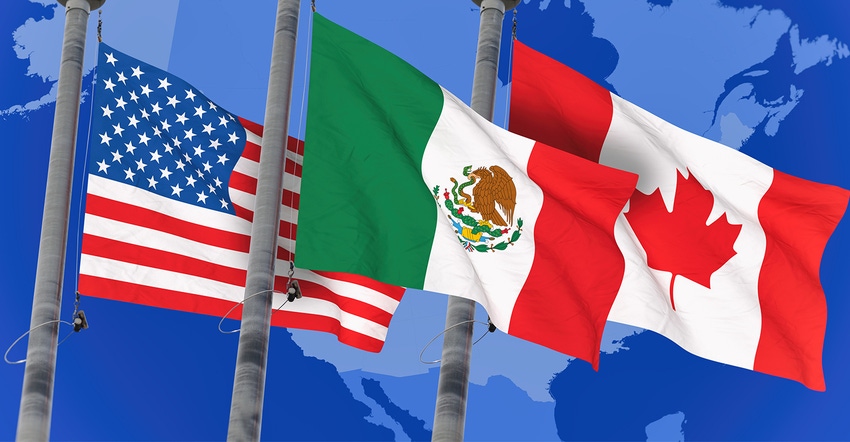
Farm Foundation, which studies agricultural issues in a neutral manner and does not lobby, issued a report last October which is disturbing for agriculture.
This report, How U.S. Agriculture Will Fare Under the USMCA and Retaliatory Tariffs, included experts from Purdue University and the Global Trade Analysis Project. This study agrees the United States-Mexico-Canada (USMCA) agreement “…will lead to an expansion of U.S. agricultural exports by $450 million, mostly in the dairy and poultry sectors.”
The Trump Administration has been touting the benefits of USMCA. But there’s a negative side.
According to the study Canada and Mexico, upset about the tariffs on their exports of steel and aluminum, have set new tariffs on U.S. agricultural exports and those exports are expected “…to decline by $1.8 billion, and by $1.9 billion to…key trading partners.”
The USMCA was signed on November 30, 2018 – a month after the Farm Foundation study was published.
Some good news
Chapter three of the USMCA covers agriculture. It includes excellent provisions, such as “No parties shall adopt or maintain an export subsidy on any agricultural good destined for the territory of another party.” There appear to be excellent provisions regarding cooperation when there is a dispute involving a restriction or a prohibition on a product.
Another positive in the agreement requires parties to limit domestic support that have “…no, or at most minimal, trade distorting effects or effects on production.” Another provision calls for the establishment of a committee on agricultural trade entitled Agricultural Committee.
Experts in the trade field tell me this is a good step forward and that the committee must meet at least once a year.
Agricultural biotechnology is discussed and has a specific definition relating to low level occurrence issues in GMO products. Another provision deals with duties relating to dairy, poultry, egg products, sugar and sugar-containing products.
Dairy, wheat wins
Another provision describes tariff rate quotas, which means a country will only allow in so many metric tons before the tariff increases substantially. Specifically, the USMCA deals with dairy pricing and exports regarding milk class 6 and milk class 7. Canada will ensure that these classes will be eliminated 6 months after the USMCA goes into effect. The Farm Foundation study indicates these changes would result in a $450 million gain for dairy.
How wheat is graded is another positive for U.S. agriculture. Canada agrees in the grain provision not to apply its Maximum Grain Revenue Entitlement. It appears this rule subsidized the transportation of wheat. There is an article on sugar and sugar-containing products (SCP) which the U.S. allocates to Canada certain amounts of sugar that can come into the U.S.
Annex 3-B discusses agricultural trade between Mexico and the United States. The first item in this Annex discusses sugar and SCPs. Several paragraphs deal with specific numbered tariff items making it impossible to interpret the impact. Annex 3-C discusses distilled spirits, wine, beer, and other alcohol beverages. One interesting provision in this section prohibits “…province of Quebec from requiring that wine sold in grocery stores in Quebec be bottled in Quebec, provided that alternative outlets are provided in Quebec for the sale of wine of the other Parties, whether or not that wine is bottled in Quebec.”
U.S. whiskey
Another curious paragraph in the USMCA states “Canada and Mexico shall recognize Bourbon whiskey and Tennessee whiskey, which is a straight Bourbon Whiskey authorized to be produced only in the State of Tennessee, as distinctive products of the United States.” Whiskey products apparently cannot be sold in Canada unless they come from Tennessee. Canadian whisky, on the other hand, is a Canadian product and cannot be sold in the U.S. unless it too is manufactured in Canada.
Farm Foundation states from 2013-2015, U.S. agricultural exports to Canada, China and Mexico represented approximately 44% of U.S. agricultural exports representing an average of $63 billion a year. The USMCA and the new potential deal with China must equal or beat this bar. And soon!
The opinions of the author are not necessarily those of Farm Futures or Farm Progress.
About the Author(s)
You May Also Like




